 | |||
|
| Home > Public Information > ING Newsletter > No. 8, September 2004 > Cute-SCIDAR: An Automatically Controlled SCIDAR Instrument for the Jacobus Kapteyn Telescope |
|
|
SCIENCE |
|
|
|
Previous: GLAS: A Laser Beacon for the WHT | Up: Table of Contents | Next: SuperWASP: The Trials and Tribulations of a Remote Inauguration Ceremony
Reference: ING Newsl., No. 8, page 15 - 18.
Article mirrored at: La Palma server | Cambridge server
Other available formats: PDF
J. J. Fuensalida1, B. García-Lorenzo1, *, J. M. Delgado1, C. Hoegemann1, M. Verde1, M. Reyes1 and J. Vernin2
1: Instituto de Astrofísica de Canarias; 2: Laboratoire Universitaire d'Astrophysique de Nice
In February 2004 the Cute-SCIDAR instrument was installed at the 1m Jacobus Kapteyn telescope (JKT) for a systematic monitoring of the atmospheric turbulence at the Observatorio del Roque de los Muchachos (ORM). The proper knowledge of the atmospheric turbulence structure is crucial for optimising the efficiency of adaptive optics systems. SCIDAR has proved to be the most contrasted and efficient technique from ground level to obtain the optical vertical structure of the atmospheric turbulence. The classical (Vernin & Roddier, 1973; Rocca, Roddier & Vernin, 1974) and generalised SCIDAR (see e.g. Klueckers et al., 1998; Ávila, Vernin & Masciadri, 1997; Fuchs, Tallon & Vernin, 1994) techniques analyse the scintillation patterns produced at the telescope pupil by the light coming from the two stars of a binary system. Turbulence profiles as a function of height, CN2 (h), are derived through the inversion of the autocorrelation of scintillation patterns. Wind vertical profiles, V(h), are derived from the cross-correlation of a series of scintillation patterns relative to a reference pattern. Figure 1 sketches the SCIDAR technique.
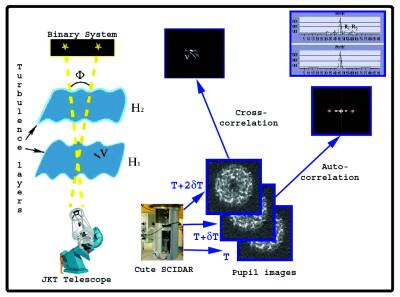
|
| Figure 1. SCIDAR technique layout. From the observation of binary stars, we get a stack of consecutive images of scintillation. The average auto-correlation function of them gives information of the CN2 profiles, and average cross-correlation functions give the wind of the layers. [ JPEG | TIFF ] |
The main drawback of SCIDAR observational campaigns is the tedious setting up of the instrumentation and the computational effort needed to infer the nightly turbulence and wind profiles. Therefore, systematic recording of turbulence and wind structure requires a huge number of highly qualified human resources. Consequently, the development of a fully automated SCIDAR device is of increasing importance to characterise the atmospheric turbulence and fix the input requirements and limits of the future multi-conjugate adaptive optic systems to be installed at the ORM. The Instituto de Astrofísica de Canarias (IAC) has developed a SCIDAR instrument providing high performance in automatic control and data reduction, the Cute-SCIDAR. It has been designed for the 1m JKT, with the goal of monitoring the vertical turbulence with a high temporal coverage. This device is not only restricted to the JKT but can also be used on other telescopes.
Technical Description
Figure 2 presents the optical scheme of the SCIDAR instrument. From the observational point of view, the SCIDAR technique requires that the detector is able to move along the optical axis to allow selection of the different conjugated planes. Moreover, the rotation around the optical axis is most than desirable for a SCIDAR instrument: because the star beams should be properly orientated on the detector (with its rows) in order to simplify the data reduction.
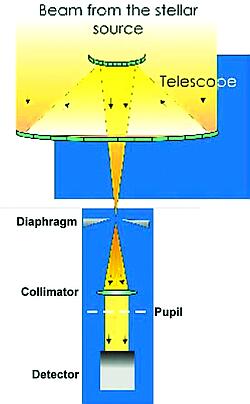
|
| Figure 2. SCIDAR instrument optical scheme. [ JPEG | TIFF ] |
The Cute-SCIDAR allows the automatic control of any of the SCIDAR instrument components. The detector is lodged in two devices permitting the motion in the XY plane (perpendicular to the optical axis) to correct the small flexure displacements in the observational plane. The maximum range in the XY plane is 25mm. A long electronically controlled rail to place the detector in the adequate conjugated plane provides the movement along the optical axis, Z direction. This motion also facilitates the instrument focusing procedure, since it permits to easily verify (using a single star) the state of collimation of the beam. The maximum displacement in the Z direction is 300mm. The current detector is a commercial sensitive CCD camera of PCO. The instrument can rotate up to 270° with respect to the telescope through a crown wheel. Another complementary mechanism is a diaphragm, placed in the focal plane of the telescope (see the scheme of Figure 2), and also electronically controlled. The diaphragm mechanism permits the proper alignment of the observing binary star with the instrument optical axis. After a short successful commissioning at the Carlos Sánchez telescope at the Observatorio del Teide in Tenerife, the Cute-SCIDAR was installed at the JKT in February 2004. Figure 3 (left) shows the Cute-SCIDAR already installed at the JKT. Figure 3 (right) shows the essential instrument components. In this figure, we can see the diaphragm and collimator (1) within the instrument cover. The detector can be seen at the bottom opened door (2) and the crown wheel is the golden ring (3) connecting the instrument and the telescope. The label (4) indicates the electronic box controlling the mechanical elements of Cute-SCIDAR.
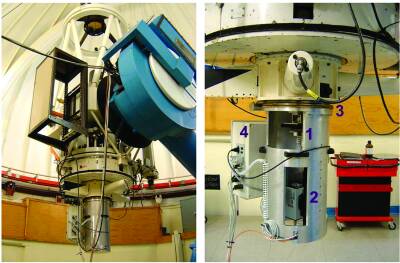
|
| Figure 3. Views of the Cute-SCIDAR instrument installed at the Jacobus Kapteyn Telescope. [ JPEG | TIFF ] |
Control Software
A specific software package for the control of the different mechanical components and a pre-processing on-line data evaluator has been developed. A user-friendly interface based on MS-WINDOWS XP allows handling the different instrument components from the telescope control room. Figure 4 shows an example of the quick-look data interface: the left upper image corresponds to the pupil image of a binary star (the data recorded at the detector), and the right upper plot is the 2D normalised auto-correlation of this image; the bottom plots are cross-correlations of the left upper image and a reference image. The bottom right plot is a X-cut along the 2D autocorrelation function showing the presence of at least two turbulence layers (the two peaks to the left and right of the central brightest peak).
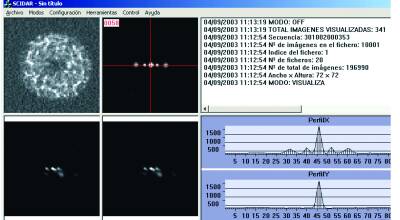
|
| Figure 4. User interface window showing an example of the on-line data evaluator. [ JPEG | TIFF ] |
Observational Campaigns at the JKT
After a successful commissioning of the Cute-SCIDAR at the JKT last February 2004, we have started a monitoring program of the atmospheric turbulence. We are carrying out monthly one-week observing SCIDAR campaigns and we already have data corresponding to 30 nights of observations. On each night we can record more than 1500 different atmospheric turbulence vertical profiles above the Observatorio del Roque de los Muchachos. Preliminary results obtained from these data have been recently presented to the astronomical community (Fuensalida et al., 2004; Hoegemann et al., 2004; Fuensalida et al., 2003). Figure 5 shows the temporal evolution of the atmospheric turbulence profiles along an observing night at the JKT. In this figure, the X-axis corresponds to the time (in UT) along the night referred to midnight. The Y-axis is the altitude above sea level, and the colour bar on the right side indicates the values of CN2(h). The dome seeing contribution has been rejected.
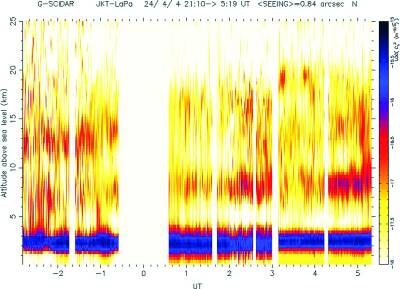
|
| Figure 5. Evolution of turbulence vertical profiles at the Observatorio del Roque de los Muchachos during the night of 23-24 April 2004. The mean seeing derived from these profiles was 0.84 arcsec being in good agreement with the DIMM measurements. [ JPEG | TIFF ] |
In semester 2004B we will continue the monitoring of the turbulence structure at the JKT after the extension of the agreement with the Isaac Newton Group of Telescopes. The Cute-SCIDAR team thanks the staff of the Isaac Newton Group of Telescopes for their usual high standard of service. ¤
References:
- Ávila, R., Vernin, J., & Masciadri, E., 1997, Appl. Opt., 36, 7898. [ First citation in text | ADS ]
- Fuensalida, J. J., Chueca, S., Delgado, J. M., García-Lorenzo, B., González-Rodríguez, J. M., Hoegemann, C., Mendizábal, E. M., Reyes, M., Verde, M., & Vernin, J., “Vertical structure of the turbulence in the observatorios of the Canary Islands: parameters and statistics for adaptive optics”, Astronomical Telescopes and Instrumentation: The industrial revolution in Astronomy, SPIE Proc., 21-25 June 2004, Glasgow, Scotland United Kingdom. [ First citation in text | ADS ]
- Fuensalida, J. J., Delgado, J. M., García-Lorenzo, B., Hoegemann, C., Reyes, M., Verde, M., & Vernin, J., “An automatically controlled SCIDAR instrument for the Roque de los Muchachos Observatory”, Second Workshop on Extremely Large Telescopes, SPIE Proc., September 7-12 2003, Backaskog, Sweden. [ First citation in text | ADS ]
- Fuchs, A., Tallon, M., &Vernin, J., 1994, SPIE Proc., 2222, 682. [ First citation in text | ADS ]
- Hoegemann, C., Chueca, S., Delgado, J. M., Fuensalida, J. J., García-Lorenzo, B., Mendizábal, E. M., Reyes, M., Verde, M., Vernin, J., “Cute SCIDAR: presentation of the new Canarian instrument and first observational results”, Astronomical Telescopes and Instrumentation: The industrial revolution in Astronomy, SPIE Proc., 21-25 June 2004, Glasgow, Scotland, United Kingdom. [ First citation in text | ADS ]
- Klueckers, V., Wooder, N., Adcock, M., & Dainty, C., 1998, A&A Suppl. Ser., 130, 141. [ First citation in text | ADS ]
- Rocca, A., Roddier, F., & Vernin, J., 1974, J. Opt. Soc. Am., 64, 1000. [ First citation in text | OSA ]
- Vernin, J., & Roddier, F., 1973, J. Opt. Soc. Am., 63, 270. [ First citation in text | OSA ]
*Email contact: Begoña García (begona.garcia@iac.es)
| Top | Back |
|

